Characteristics of Fungi Best 14 Classification
Characteristics of Fungi are thallophyta plants i.e. their bodies are not divided into main parts, stem and leaves. Almost all fungal bodies except unicellular fungi are composed of depressed hyphae. They cannot make their own food because they have chlorophyll in their bodies. Fungi are parasites or midges and take food absorption process. Fungal cell … Read more








